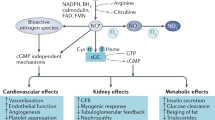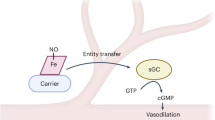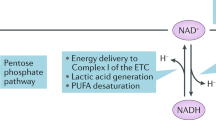Abstract
Inorganic nitrite (NO2−) is emerging as a regulator of physiological functions and tissue responses to ischemia, whereas the more stable nitrate anion (NO3−) is generally considered to be biologically inert. Bacteria express nitrate reductases that produce nitrite, but mammals lack these specific enzymes. Here we report on nitrate reductase activity in rodent and human tissues that results in formation of nitrite and nitric oxide (NO) and is attenuated by the xanthine oxidoreductase inhibitor allopurinol. Nitrate administration to normoxic rats resulted in elevated levels of circulating nitrite that were again attenuated by allopurinol. Similar effects of nitrate were seen in endothelial NO synthase–deficient and germ-free mice, thereby excluding vascular NO synthase activation and bacteria as the source of nitrite. Nitrate pretreatment attenuated the increase in systemic blood pressure caused by NO synthase inhibition and enhanced blood flow during post-ischemic reperfusion. Our findings suggest a role for mammalian nitrate reduction in regulation of nitrite and NO homeostasis.
This is a preview of subscription content, access via your institution
Access options
Subscribe to this journal
Receive 12 print issues and online access
$259.00 per year
only $21.58 per issue
Buy this article
- Purchase on Springer Link
- Instant access to full article PDF
Prices may be subject to local taxes which are calculated during checkout





Similar content being viewed by others
References
Forstermann, U. & Munzel, T. Endothelial nitric oxide synthase in vascular disease: from marvel to menace. Circulation 113, 1708–1714 (2006).
Ignarro, L.J. Nitric oxide as a unique signaling molecule in the vascular system: a historical overview. J. Physiol. Pharmacol. 53, 503–514 (2002).
Weitzberg, E. & Lundberg, J.O. Nonenzymatic nitric oxide production in humans. Nitric Oxide 2, 1–7 (1998).
Lundberg, J.O., Weitzberg, E. & Gladwin, M.T. The nitrate-nitrite-nitric oxide pathway in physiology and therapeutics. Nat. Rev. Drug Discov. 7, 156–167 (2008).
Gladwin, M.T. et al. The emerging biology of the nitrite anion. Nat. Chem. Biol. 1, 308–314 (2005).
Zweier, J.L., Samouilov, A. & Kuppusamy, P. Non-enzymatic nitric oxide synthesis in biological systems. Biochim. Biophys. Acta 1411, 250–262 (1999).
Cosby, K. et al. Nitrite reduction to nitric oxide by deoxyhemoglobin vasodilates the human circulation. Nat. Med. 9, 1498–1505 (2003).
Nagababu, E., Ramasamy, S., Abernethy, D.R. & Rifkind, J.M. Active nitric oxide produced in the red cell under hypoxic conditions by deoxyhemoglobin-mediated nitrite reduction. J. Biol. Chem. 278, 46349–46356 (2003).
Zhang, Z. et al. Human xanthine oxidase converts nitrite ions into nitric oxide (NO). Biochem. Soc. Trans. 25, 524S (1997).
Webb, A. et al. Reduction of nitrite to nitric oxide during ischemia protects against myocardial ischemia-reperfusion damage. Proc. Natl. Acad. Sci. USA 101, 13683–13688 (2004).
Shiva, S. et al. Deoxymyoglobin is a nitrite reductase that generates nitric oxide and regulates mitochondrial respiration. Circ. Res. 100, 654–661 (2007).
Rassaf, T. et al. Nitrite reductase function of deoxymyoglobin: oxygen sensor and regulator of cardiac energetics and function. Circ. Res. 100, 1749–1754 (2007).
Kozlov, A.V., Staniek, K. & Nohl, H. Nitrite reductase activity is a novel function of mammalian mitochondria. FEBS Lett. 454, 127–130 (1999).
Carlsson, S., Wiklund, N.P., Engstrand, L., Weitzberg, E. & Lundberg, J.O. Effects of pH, nitrite, and ascorbic acid on nonenzymatic nitric oxide generation and bacterial growth in urine. Nitric Oxide 5, 580–586 (2001).
Gago, B., Lundberg, J.O., Barbosa, R.M. & Laranjinha, J. Red wine-dependent reduction of nitrite to nitric oxide in the stomach. Free Radic. Biol. Med. 43, 1233–1242 (2007).
Peri, L. et al. Apples increase nitric oxide production by human saliva at the acidic pH of the stomach: a new biological function for polyphenols with a catechol group? Free Radic. Biol. Med. 39, 668–681 (2005).
Lundberg, J.O., Weitzberg, E., Lundberg, J.M. & Alving, K. Intragastric nitric oxide production in humans: measurements in expelled air. Gut 35, 1543–1546 (1994).
Bryan, N.S. et al. Nitrite is signalling molecule and regulator of gene expression in mammalian tissue. Nat. Chem. Biol. 1, 290–297 (2005).
Shiva, S. et al. Ceruloplasmin is a NO oxidase and nitrite synthase that determines endocrine NO homeostasis. Nat. Chem. Biol. 2, 486–493 (2006).
Lundberg, J.O. & Weitzberg, E. NO generation from nitrite and its role in vascular control. Arterioscler. Thromb. Vasc. Biol. 25, 915–922 (2005).
Lundberg, J.O., Weitzberg, E., Cole, J.A. & Benjamin, N. Nitrate, bacteria and human health. Nat. Rev. Microbiol. 2, 593–602 (2004).
Spiegelhalder, B., Eisenbrand, G. & Preussman, R. Influence of dietary nitrate on nitrite content of human saliva: possible relevance to in vivo formation of N-nitroso compounds. Food Cosmet. Toxicol. 14, 545–548 (1976).
Duncan, C. et al. Chemical generation of nitric oxide in the mouth from the enterosalivary circulation of dietary nitrate. Nat. Med. 1, 546–551 (1995); comment 1, 515–517 (1995).
Lundberg, J.O. & Govoni, M. Inorganic nitrate is a possible source for systemic generation of nitric oxide. Free Radic. Biol. Med. 37, 395–400 (2004).
Moreno-Vivian, C., Cabello, P., Martinez-Luque, M., Blasco, R. & Castillo, F. Prokaryotic nitrate reduction: molecular properties and functional distinction among bacterial nitrate reductases. J. Bacteriol. 181, 6573–6584 (1999).
Moncada, S., Palmer, R.M.J. & Higgs, E.A. Nitric oxide: physiology, pathophysiology, and pharmacology. Pharmacol. Rev. 43, 109–141 (1991).
Ward, F.W., Coates, M.E. & Walker, R. Nitrate reduction, gastro-intestinal pH and N-nitrosation in gnotobiotic and conventional rats. Food Chem. Toxicol. 24, 17–22 (1986).
Ward, F.W., Coates, M.E., Cole, C.B. & Fuller, R. Effect of dietary fats on endogenous formation of N-nitrosamines from nitrate in germ-free and conventional rats and rats harbouring a human flora. Food Addit. Contam. 7, 597–604 (1990).
Fritsch, P., de Saint Blanquat, G. & Klein, D. Excretion of nitrates and nitrites in saliva and bile in the dog. Food Chem. Toxicol. 23, 655–659 (1985).
Alikulov, Z.A., L'Vov, N.P. & Kretovich, V.L. Nitrate and nitrite reductase activity of milk xanthine oxidase. Biokhimiia 45, 1714–1718 (1980).
Li, H., Samouilov, A., Liu, X. & Zweier, J.L. Characterization of the magnitude and kinetics of xanthine oxidase-catalyzed nitrate reduction: evaluation of its role in nitrite and nitric oxide generation in anoxic tissues. Biochemistry 42, 1150–1159 (2003).
Millar, T.M. et al. Xanthine oxidoreductase catalyses the reduction of nitrates and nitrite to nitric oxide under hypoxic conditions. FEBS Lett. 427, 225–228 (1998).
Gustafsson, B.E. The physiological importance of the colonic microflora. Scand. J. Gastroenterol. Suppl. 77, 117–131 (1982).
Sarnesto, A., Linder, N. & Raivio, K.O. Organ distribution and molecular forms of human xanthine dehydrogenase/xanthine oxidase protein. Lab. Invest. 74, 48–56 (1996).
Lambers, A.C. et al., The oral bioavailability study of nitrate from vegetables in healthy volunteeers (report no. 2358020156) 1–47 (National Institute of Public Health and the Environment (RIVM), Bilthoven, The Netherlands, 2000).
Dejam, A. et al. Nitrite infusion in humans and nonhuman primates: endocrine effects, pharmacokinetics, and tolerance formation. Circulation 116, 1821–1831 (2007).
Larsen, F.J., Ekblom, B., Sahlin, K., Lundberg, J.O. & Weitzberg, E. Effects of dietary nitrate on blood pressure in healthy volunteers. N. Engl. J. Med. 355, 2792–2793 (2006).
Larsen, F.J., Weitzberg, E., Lundberg, J.O. & Ekblom, B. Effects of dietary nitrate on oxygen cost during exercise. Acta Physiol. (Oxf.) 191, 59–66 (2007).
Duranski, M.R. et al. Cytoprotective effects of nitrite during in vivo ischemia-reperfusion of the heart and liver. J. Clin. Invest. 115, 1232–1240 (2005).
Jung, K.H. et al. Early intravenous infusion of sodium nitrite protects brain against in vivo ischemia-reperfusion injury. Stroke 37, 2744–2750 (2006).
Tripatara, P. et al. Nitrite-derived nitric oxide protects the rat kidney against ischemia/reperfusion injury in vivo: role for xanthine oxidoreductase. J. Am. Soc. Nephrol. 18, 570–580 (2007).
Bryan, N.S. et al. Dietary nitrite supplementation protects against myocardial ischemia-reperfusion injury. Proc. Natl. Acad. Sci. USA 104, 19144–19149 (2007).
Speijers, G.J.A. & van den Brandt, P.A. Nitrate and potential endogenous formation of N-nitroso compounds. WHO Food Additives Series: 50 <http://www.inchem.org/documents/jecfa/jecmono/v50je06.htm> (2006).
Kelley, E.E. et al. Moderate hypoxia induces xanthine oxidoreductase activity in arterial endothelial cells. Free Radic. Biol. Med. 40, 952–959 (2006).
Green, D.J., Maiorana, A., O'Driscoll, G. & Taylor, R. Effect of exercise training on endothelium-derived nitric oxide function in humans. J. Physiol. (Lond.) 561, 1–25 (2004).
Jungersten, L., Ambring, A., Wall, B. & Wennmalm, A. Both physical fitness and acute exercise regulate nitric oxide formation in healthy humans. J. Appl. Physiol. 82, 760–764 (1997).
Crawford, J.H. et al. Transduction of NO-bioactivity by the red blood cell in sepsis: novel mechanisms of vasodilation during acute inflammatory disease. Blood 104, 1375–1382 (2004).
Webb, A.J. et al. Acute blood pressure lowering, vasoprotective, and antiplatelet properties of dietary nitrate via bioconversion to nitrite. Hypertension 51, 784–790 (2008).
Lundberg, J.O., Feelisch, M., Bjorne, H., Jansson, E.A. & Weitzberg, E. Cardioprotective effects of vegetables: is nitrate the answer? Nitric Oxide 15, 359–362 (2006).
Acknowledgements
We thank the European Union (Eicosanox, LSMH-CT-2004-005033), Vinnova (KIDaT, chronic inflammation), Torsten & Ragnar Söderbergs Foundation, the Swedish Research Council, the Swedish Heart & Lung Foundation and a regional agreement between Stockholm County Council and Karolinska Institutet for generous support. We thank I. Johansson (Department of Physiology and Pharmacology, Karolinska Institutet) for kindly providing us with the human liver samples and J. Sällström (Uppsala University) for the Nos3−/− mice.
Author information
Authors and Affiliations
Contributions
E.Å.J., L. Huang, R.M., M.G., C.N., A.O., M.S. and J.P. performed experiments. All authors participated in the design and analysis of various experiments. J.O.L., E.Å.J. and E.W. wrote the paper.
Corresponding author
Ethics declarations
Competing interests
J.O.L. and E.W. are named inventors on a patent application for the therapeutic use of inorganic nitrate and nitrite salts.
Supplementary information
Supplementary Text and Figures
Supplementary Figures 1–4, Supplementary Table 1 and Supplementary Methods (PDF 334 kb)
Rights and permissions
About this article
Cite this article
Jansson, E., Huang, L., Malkey, R. et al. A mammalian functional nitrate reductase that regulates nitrite and nitric oxide homeostasis. Nat Chem Biol 4, 411–417 (2008). https://doi.org/10.1038/nchembio.92
Received:
Accepted:
Published:
Issue Date:
DOI: https://doi.org/10.1038/nchembio.92



